Introduction To Personal And Advertising Injury
Personal injury means harm to a person’s body or mind. This includes injuries like physical harm, emotional distress, or mental suffering. Advertising injury is harm caused by false or harmful statements in ads. This includes things like defamation or false advertising.
Importance In Legal And Insurance Contexts
Understanding personal and advertising injury is key for both legal and insurance matters. In the legal world, these terms help define the type of harm someone can seek compensation for. For insurance, knowing these types of injuries helps determine what is covered and how claims are handled.
Personal Injury
Personal injury refers to harm caused to a person’s body or mind. This can include physical injuries, emotional distress, or mental suffering. It covers any situation where someone suffers due to another person’s actions or negligence.
Common Examples
Examples of personal injury include bodily harm from an accident, emotional distress from harassment, and mental suffering from trauma. These injuries affect a person’s overall well-being and quality of life.
Legal Aspects And Claims Process
In the legal world, a personal injury claim involves proving that someone else is responsible for the harm. The process usually starts with filing a claim, gathering evidence, and negotiating with insurance companies. If needed, the case may go to court to seek compensation for damages like medical bills and lost wages.
Advertising Injury
- Definition and Scope
- Common Examples (e.g., defamation, false advertising)
- Legal Aspects and Claims Process
Differences Between Personal And Advertising Injury
Personal injury and advertising injury are different types of harm. Personal injury deals with physical harm or emotional distress directly affecting a person. Advertising injury involves harm caused by false or harmful statements in advertisements.
How Each Type Affects Individuals and Businesses
Personal injury affects individuals by causing physical pain, emotional suffering, or mental distress. This can lead to medical bills, lost wages, and a lower quality of life. Advertising injury impacts businesses by damaging their reputation, leading to legal issues, and causing financial loss. It can result in lawsuits and require businesses to make changes in their advertising practices.
Insurance Coverage For Personal And Advertising Injury
Insurance policies that cover personal and advertising injury include liability insurance and business insurance. Liability insurance helps protect individuals and businesses from claims related to personal injury. Business insurance often covers advertising injury.
Coverage Details And Limitations
Liability insurance usually covers costs related to personal injury like medical bills and legal fees. However, it may have limits on the amount it will pay and certain exclusions. Business insurance covers costs for advertising injury, such as damages from false advertising claims. Coverage details vary by policy, and there may be limits or specific conditions. It’s important to understand what is covered and any exclusions to ensure proper protection.
Legal Recourse And Remedies
For personal injury, individuals can file a lawsuit to seek compensation. This often involves proving that another party’s negligence or intentional harm caused the injury. Common legal actions include filing for damages in civil court. The goal is to get compensation for medical bills, lost wages, and pain and suffering.
Legal Actions for Advertising Injury
For advertising injury, businesses can take legal action if they suffer harm from false or damaging ads. They can file lawsuits for defamation, false advertising, or other related claims. The process involves proving that the advertisement harmed the business and led to financial loss or damage to its reputation.
Potential Compensation And Damages
In personal injury cases, potential compensation can include medical expenses, lost wages, and damages for pain and suffering. For advertising injury, compensation may cover financial losses, damages to reputation, and legal fees. The amount of compensation depends on the severity of the injury and the specifics of the case.
Preventing And Mitigating Risks
Tips For Individuals
To prevent personal injury, follow safety guidelines and be cautious in daily activities. Wear protective gear when needed and seek prompt medical attention for any injuries. To reduce emotional distress, maintain good mental health practices and seek support if needed.
Tips For Businesses
To avoid advertising injury, ensure all ads are accurate and truthful. Review advertising materials carefully to prevent false claims or misleading statements. Implement clear policies for handling complaints and legal issues related to ads. Regularly train staff on compliance with advertising laws and best practices.
Case Studies And Examples
Real-life Examples Of Personal Injury Cases
- Car Accident: A person injured in a car accident can file a claim for medical expenses and lost wages. For example, if someone suffers a broken leg due to a driver’s negligence, they can seek compensation for surgery and rehabilitation costs.
- Slip and Fall: An individual who slips and falls on a wet floor in a store can file a personal injury claim. They might claim damages for medical bills, lost income, and pain and suffering caused by the fall.
Real-life Examples Of Advertising Injury Cases
- False Advertising: A company falsely claims that its product can cure diseases. If another business loses customers due to these false claims, it can file a claim for advertising injury. The harmed business can seek compensation for financial losses and damage to its reputation.
- Defamation: A business is featured in an advertisement that makes false and damaging claims about its services. The business can sue for advertising injury to recover damages related to lost revenue and harm to its public image.
Conclusion
Personal and advertising injury cover different types of harm, with personal injury involving physical or emotional damage to individuals and advertising injury relating to false or harmful claims in ads. Understanding these terms is crucial for both legal and insurance contexts, as it helps individuals and businesses navigate claims and protection. Knowing the differences and how to address each type of injury ensures better preparedness for legal issues and financial recovery.
FAQS
What Is Personal Injury In Insurance?
Personal injury in insurance covers claims involving harm to someone’s reputation, rights, or feelings. Examples include defamation, wrongful eviction, and invasion of privacy.
What Is Advertising Injury In Insurance?
Advertising injury protects businesses from claims of wrongdoing in their advertising. It includes copyright infringement, libel, and slander related to ads.
How Are Personal Injury And Advertising Injury Different?
Personal injury deals with harm to individuals, while advertising injury relates to businesses harming others through their advertisements.
What Does Personal Injury Coverage Protect Against?
It protects against claims like defamation, false arrest, wrongful eviction, and invasion of privacy.















Got a Questions?
Find us on Socials or Contact us and we’ll get back to you as soon as possible.